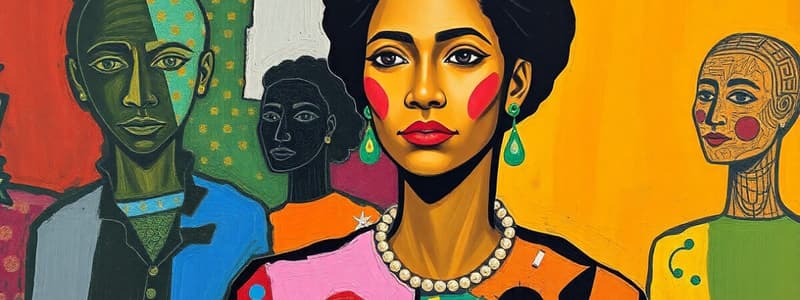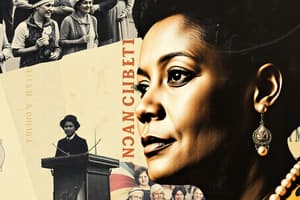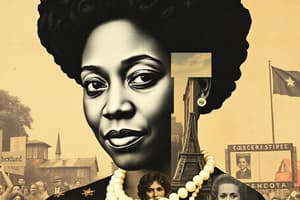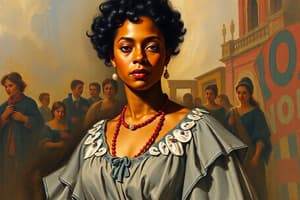Podcast
Questions and Answers
Which of the following organizations did Mary Church Terrell NOT help found?
Which of the following organizations did Mary Church Terrell NOT help found?
- The Colored Woman's League of Washington
- The National Association of Colored Women
- The National Association for the Advancement of Colored People
- The National Woman's Party (correct)
How did Mary Church Terrell experience prejudice in the South?
How did Mary Church Terrell experience prejudice in the South?
- She was not allowed ride in segregated train cars.
- She was barred from restaurants.
- She was refused hotel rooms.
- All of the above (correct)
What did Mary Church Terrell fear during her time in the South?
What did Mary Church Terrell fear during her time in the South?
- She feared she would be denied service at a restaurant.
- She feared she would be barred from entering a hotel.
- She feared for her life. (correct)
- She feared she would be refused access to a segregated train car.
Why did Mary Church Terrell feel that she had been on the right side of the question?
Why did Mary Church Terrell feel that she had been on the right side of the question?
What was Mary Church Terrell's main goal in advocating for women's suffrage?
What was Mary Church Terrell's main goal in advocating for women's suffrage?
How is Mary Church Terrell's work described in the passage?
How is Mary Church Terrell's work described in the passage?
What does the quote "And so, lifting as we climb, onward and upward we go, struggling and striving" suggest about Mary Church Terrell's approach to social change?
What does the quote "And so, lifting as we climb, onward and upward we go, struggling and striving" suggest about Mary Church Terrell's approach to social change?
How did Mary Church Terrell's work contribute to the modern civil rights movement?
How did Mary Church Terrell's work contribute to the modern civil rights movement?
Which reform was Harriot Stanton Blatch particularly concerned with in relation to women's suffrage?
Which reform was Harriot Stanton Blatch particularly concerned with in relation to women's suffrage?
What statement is associated with the efforts of early leaders like Mary Church Terrell in the suffrage movement?
What statement is associated with the efforts of early leaders like Mary Church Terrell in the suffrage movement?
What did Harriot Stanton Blatch believe about the future enthusiasm for the suffrage movement?
What did Harriot Stanton Blatch believe about the future enthusiasm for the suffrage movement?
What tragic event highlighted the lack of protection for women in the workforce?
What tragic event highlighted the lack of protection for women in the workforce?
Which phrase reflects Mary Church Terrell's perspective on progress?
Which phrase reflects Mary Church Terrell's perspective on progress?
What was the overarching theme of the image dedicated to Mary Church Terrell?
What was the overarching theme of the image dedicated to Mary Church Terrell?
Which characteristic is commonly associated with early leaders of the suffrage movement?
Which characteristic is commonly associated with early leaders of the suffrage movement?
How did the suffrage movement change over time according to the passage?
How did the suffrage movement change over time according to the passage?
What realization did Mary Church have when she was a child?
What realization did Mary Church have when she was a child?
What specific event led to Mary Church's realization about her race?
What specific event led to Mary Church's realization about her race?
What is the primary message conveyed by the title, "Lifting as we Climb, Onward and Upward We Go"?
What is the primary message conveyed by the title, "Lifting as we Climb, Onward and Upward We Go"?
Flashcards
Mary Church Terrell's main goal
Mary Church Terrell's main goal
Mary Church Terrell was an African American activist, writer, and suffragist who dedicated her life to fighting for social justice and equality. She was a strong advocate for education as a means of empowerment and worked tirelessly to improve the lives of African Americans in the United States.
What sparked Mary Church Terrell's activism?
What sparked Mary Church Terrell's activism?
Mary Church Terrell's childhood experience with racism at a boarding school in Ohio had a profound impact on her. It made her aware of the prejudice and discrimination that African Americans faced and fueled her determination to fight for racial equality.
Mary Church Terrell's understanding of racial inequality
Mary Church Terrell's understanding of racial inequality
Despite her privileged upbringing, Mary Church Terrell recognized the struggles and injustices experienced by most African Americans. While she had access to education and wealth, she understood the need to uplift those who lacked those opportunities, recognizing the systemic barriers they faced.
How did Mary Church Terrell view the role of education?
How did Mary Church Terrell view the role of education?
Signup and view all the flashcards
Mary Church Terrell's contribution to education
Mary Church Terrell's contribution to education
Signup and view all the flashcards
Mary Church Terrell's marriage and its significance
Mary Church Terrell's marriage and its significance
Signup and view all the flashcards
Mary Church Terrell's advocacy beyond education
Mary Church Terrell's advocacy beyond education
Signup and view all the flashcards
Mary Church Terrell's activism
Mary Church Terrell's activism
Signup and view all the flashcards
Organizations founded by Mary Church Terrell
Organizations founded by Mary Church Terrell
Signup and view all the flashcards
Mary Church Terrell and women's suffrage
Mary Church Terrell and women's suffrage
Signup and view all the flashcards
Terrell's view on the word "people"
Terrell's view on the word "people"
Signup and view all the flashcards
Terrell's advocacy in the South
Terrell's advocacy in the South
Signup and view all the flashcards
Terrell's experience in the North
Terrell's experience in the North
Signup and view all the flashcards
Terrell's bridge-building efforts
Terrell's bridge-building efforts
Signup and view all the flashcards
Terrell's lifelong activism
Terrell's lifelong activism
Signup and view all the flashcards
What did Mary Church Terrell's quote "Seeking no favors because of our color, nor patronage because of our needs, we knock at the bar of justice, asking an equal chance." mean?
What did Mary Church Terrell's quote "Seeking no favors because of our color, nor patronage because of our needs, we knock at the bar of justice, asking an equal chance." mean?
Signup and view all the flashcards
How did Mary Church Terrell view progress and tradition?
How did Mary Church Terrell view progress and tradition?
Signup and view all the flashcards
What was Mary Church Terrell's belief on the role of education for African Americans?
What was Mary Church Terrell's belief on the role of education for African Americans?
Signup and view all the flashcards
How did Harriot Stanton Blatch view the role of working women in the suffrage movement?
How did Harriot Stanton Blatch view the role of working women in the suffrage movement?
Signup and view all the flashcards
How did Harriot Stanton Blatch believe women's suffrage would impact labor practices?
How did Harriot Stanton Blatch believe women's suffrage would impact labor practices?
Signup and view all the flashcards
What tragedy highlighted the need for labor reform in industries with predominantly female workers?
What tragedy highlighted the need for labor reform in industries with predominantly female workers?
Signup and view all the flashcards
How did the suffrage movement evolve and gain strength?
How did the suffrage movement evolve and gain strength?
Signup and view all the flashcards
How did the suffrage movement change over time?
How did the suffrage movement change over time?
Signup and view all the flashcards
Study Notes
Mary Church Terrell
- Born September 23, 1863, died July 24, 1954
- Experienced racial discrimination at a young age. Realized she was treated differently due to her skin color at school.
- Attended a boarding school in Ohio which enrolled both white and African American children.
- Recognized early prejudice from white peers who ridiculed her because of her race.
- Childhood in the South was unusual
- Her father, a former slave and son of a slaveholder, built a fortune in real estate.
- Her mother owned a hair salon, a rare achievement for women at the time.
- Attended private schools and Oberlin College, becoming one of the first African American women to attend.
Education and Activism
- Learned three languages (besides English): German, French, and Italian
- Lectured overseas, gaining praise for her ability to speak different languages
- Worked in organizations focused on African American rights
- Founded/involved with: Colored Woman's League of Washington, National Association of Colored Women, National Association for the Advancement of Colored People (NAACP), and the College Alumnae Club
- Actively fought for women's suffrage, working to gain the vote for women.
- Met Susan B. Anthony in 1898.
- Encountered discrimination in the South for her activism.
- Faced segregation and discrimination in hotels and restaurants.
- Worked to improve education, jobs, healthcare, and living conditions for African Americans
- Her hard work led to increased opportunity and better living conditions for African Americans.
- Became involved in the women's suffrage movement.
- Supported the suffrage movement, but focused on the challenges faced by African American women.
- Focused on education and activism that could change living conditions and create opportunities.
- Was involved in 29 different clubs over a twelve year period.
Personal Life and Later Years
- Married Robert Terrell, a Harvard-educated lawyer, and first African American man to be named a municipal court judge
- Forced to stop teaching after marriage; focused her energy on reform causes
- Faced criticism and opposition in the South, regarding women's suffrage
- Worked with suffragist groups, including the National Woman's Party
- A pioneer of the modern civil rights movement
- Continued activism in her later years, fighting segregation in restaurants and other public places
- Served as a role model and pioneer
- Emphasized education as a path to progress for African Americans in contrast to white suffragists who seemed indifferent to race.
Studying That Suits You
Use AI to generate personalized quizzes and flashcards to suit your learning preferences.




